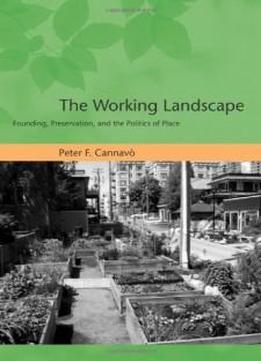
The Working Landscape: Founding, Preservation, And The Politics Of Place (urban And Industrial Environments)
by Peter F. Cannavò /
2007 / English / PDF
3.1 MB Download
In America today we see rampant development, unsustainable
resource exploitation, and commodification ruin both natural and
built landscapes, disconnecting us from our surroundings and
threatening our fundamental sense of place. Meanwhile,
preservationists often respond with a counterproductive stance
that rejects virtually any change in the landscape. In
In America today we see rampant development, unsustainable
resource exploitation, and commodification ruin both natural and
built landscapes, disconnecting us from our surroundings and
threatening our fundamental sense of place. Meanwhile,
preservationists often respond with a counterproductive stance
that rejects virtually any change in the landscape. InThe
Working Landscape
The
Working Landscape, Peter Cannavò identifies this zero-sum
conflict between development and preservation as a major factor
behind our contemporary crisis of place. Cannavò offers practical
and theoretical alternatives to this deadlocked, polarized
politics of place by proposing an approach that embraces both
change and stability and unifies democratic and ecological
values, creating a "working landscape."
, Peter Cannavò identifies this zero-sum
conflict between development and preservation as a major factor
behind our contemporary crisis of place. Cannavò offers practical
and theoretical alternatives to this deadlocked, polarized
politics of place by proposing an approach that embraces both
change and stability and unifies democratic and ecological
values, creating a "working landscape."
Place, Cannavò argues, is not just an object but an essential
human practice that involves the physical and conceptual
organization of our surroundings into a coherent, enduring
landscape. This practice must balance development (which he calls
"founding") and preservation. Three case studies illustrate the
polarizing development-preservation conflict: the debate over the
logging of old-growth forests in the Pacific Northwest; the
problem of urban sprawl; and the redevelopment of the former site
of the World Trade Center in New York City. Cannavò suggests that
regional, democratic governance is the best framework for
integrating development and preservation, and he presents
specific policy recommendations that aim to create a "working
landscape" in rural, suburban, and urban areas. A postscript on
the mass exile, displacement, and homelessness caused by
Hurricane Katrina considers the implications of future climate
change for the practice of place.
Place, Cannavò argues, is not just an object but an essential
human practice that involves the physical and conceptual
organization of our surroundings into a coherent, enduring
landscape. This practice must balance development (which he calls
"founding") and preservation. Three case studies illustrate the
polarizing development-preservation conflict: the debate over the
logging of old-growth forests in the Pacific Northwest; the
problem of urban sprawl; and the redevelopment of the former site
of the World Trade Center in New York City. Cannavò suggests that
regional, democratic governance is the best framework for
integrating development and preservation, and he presents
specific policy recommendations that aim to create a "working
landscape" in rural, suburban, and urban areas. A postscript on
the mass exile, displacement, and homelessness caused by
Hurricane Katrina considers the implications of future climate
change for the practice of place.











